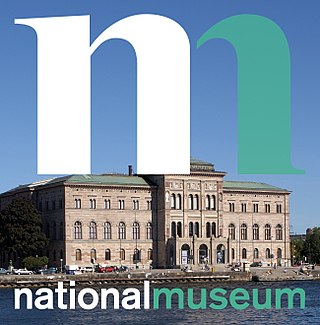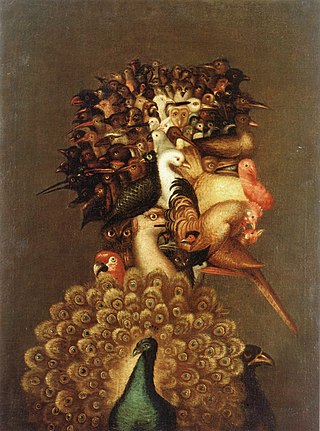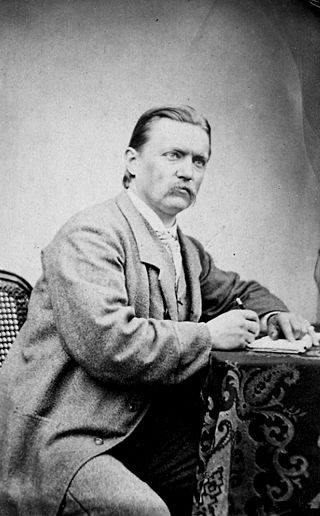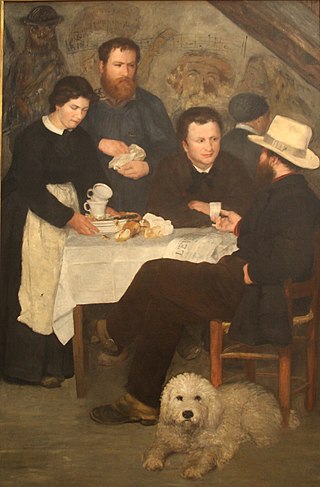
Nationalmuseum is the national gallery of Sweden, located on the peninsula Blasieholmen, in central Stockholm.

Jean-Baptiste Oudry was a French Rococo painter, engraver, and tapestry designer. He is particularly well known for his naturalistic pictures of animals and his hunt pieces depicting game. His son, Jacques-Charles Oudry, was also a painter.

Evaristo Baschenis was an Italian Baroque painter of the 17th century, active mainly around his native city of Bergamo.

Alexander Roslin was a Swedish painter who worked in Scania, Bayreuth, Paris, Italy, Warsaw and St. Petersburg, primarily for members of aristocratic families. He combined insightful psychological portrayal with a skillful representation of fabrics and jewels.

The Jurist, also known as The Lawyer, is an oil-on-canvas painting by Italian artist Giuseppe Arcimboldo, painted in 1566.
Events from the year 1566 in art.

People often see hidden faces in things. Depending on the circumstances, this is referred to as pareidolia, the perception or recognition of a specific pattern or form in something essentially different. It is thus also a kind of optical illusion. When an artist notices that two different things have a similar appearance, and draws or paints a picture making this similarity evident, they make images with double meanings. Many of these images are hidden faces or hidden skulls.
Events from the year 1586 in art.

The Lictors Bring to Brutus the Bodies of His Sons is a work in oils by the French artist Jacques-Louis David. On a canvas of 146 square feet, this painting was first exhibited at the Paris Salon in 1789. The subject is the Roman leader Lucius Junius Brutus, founder of the Roman Republic, contemplating the fate of his sons. They had conspired to overthrow the republic and restore the monarchy, and Brutus himself was compelled to order their deaths. In doing so, Brutus became the heroic defender of the republic, at the cost of his own family. The painting was a bold allegory of civic virtue with immense resonance for the growing cause of republicanism. Its themes of virtue, sacrifice, and devotion to the nation sparked much controversy when it was unveiled in the politically charged era of the French Revolution.

Eva Fredrika Bonnier was a Swedish painter and philanthropist.

Hanna Hirsch, later Hanna Pauli, was a Swedish painter; primarily of genre scenes and portraits.

Giuseppe Arcimboldo, also spelled Arcimboldi, was an Italian Renaissance painter best known for creating imaginative portrait heads made entirely of objects such as fruits, vegetables, flowers, fish and books.

The Four Elements is a series of four oil paintings by the Italian artist Giuseppe Arcimboldo which were created in 1566, during the Renaissance, for Maximilian II, Holy Roman Emperor. The paintings depict human faces in profile made up from different animals or objects. Air is represented by birds, Fire by burning wood and cannons, Earth by land animals and Water by marine creatures. The series attempts to express the creation of harmony from chaos by the careful arrangement of the wild animals to form portraits whilst also praising Maximilian by suggesting that he is a ruler who controls even the four primal elements.

Vertumnus is an oil painting produced by the Italian painter Giuseppe Arcimboldo in 1591 that consists of multiple fruits, vegetables and flowers that come together to create a portrait of Holy Roman Emperor Rudolf II. Although Arcimboldo's colleagues commented that Vertumnus was scherzo, or humorous, there were intentional political meanings behind the piece, particularly regarding the choice of fruits, vegetables, and flowers. Arcimboldo's choice to include these items was also an intentional reference to the Roman god, Vertumnus.

Ferdinand Julius Fagerlin was a Swedish-German genre painter.

The Town is a 1903 oil painting by August Strindberg. It is shown at the Nationalmuseum in Stockholm.

The Seasons or The Four Seasons is a set of four paintings produced in 1563, 1572 and 1573 by the Italian artist Giuseppe Arcimboldo. He offered the set to Maximilian II, Holy Roman Emperor in 1569, accompanying The Four Elements. Each shows a profile portrait made up of fruit, vegetables and plants relating to the relevant season. The set was accompanied by a poem by Giovanni Battista Fonteo (1546–1580) explaining their allegorical meaning.

The Fruit Basket or Reversible Head with a Fruit Basket is a c.1590 oil-on-panel still life by the Italian painter Giuseppe Arcimboldo. It is held in the French & Company collection, in New York. When inverted, it shows an anthropomorphic head by pareidolia. The same painter also produced The Cook and The Gardener.

Self-Portrait in a Gorget is an oil on panel self-portrait by Dutch painter Rembrandt, created c. 1629. It is held in the Germanisches Nationalmuseum, in Nuremberg.

Mother Anthony's Tavern, also known as At the Inn of Mother Anthony, is an 1866 oil-on-canvas painting made by French artist Pierre-Auguste Renoir during his Fontainebleau period. It is one of Renoir's first major paintings, having completed it at the age of 25. The work is currently in the collection of the Nationalmuseum in Stockholm.



















